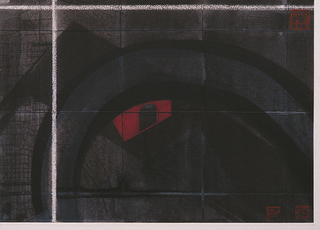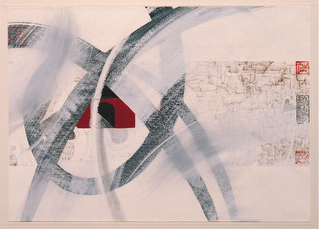Leo Duff (KU) Stone Upon Broken Stone



Stone Upon Broken Stone
Stone Upon Broken Stone was a phrase I saw high up on a long side wall of the vast Guinness brewery in Dublin in 1981. The words stayed with me as a type of memorial for that area of Dublin - St James Gate and The Liberties - and all of the ways of life they represented over many centuries. From early man through Viking invasions, the poverty associated with living outside the edge of the old city walls (known as the Liberties) and the phenomenon which is Guinness itself and its world wide distribution making the name St James Gate known across and in even the remotest parts of the globe. The constant demolition and rebuilding and the waxing and waning of the use of buildings in many parts of Ireland are a long term theme in my work. Stone Upon Broken Stone sums this up perfectly, and as my travels increased, became the expression which described the way I have been looking at mans use and reuse of stone and other building materials in Southern and Northern Ireland, the Boarders in Scotland, Croatia, Montenegro, Taiwan, The Peoples Republic of China, Mumbai and New Delhi in India, Byblos and Beirut in Lebanon, and Seoul in South Korea. Stone Upon Broken Stone also takes on a political edge when seen in the light of the changes which have occurred in the places people live and how they have relocated under the influence of change. Change for the better or change for the worse is not my theme however, it is the way change has affected the ways of building and rebuilding the ordinary places we inhabit.
As a whole, Stone Upon Broken Stone looks at the application of materials in buildings which are part of our normal lives, rather than grandiose or monumental architecture. The use, re-use and application of natural and recycled stone in its natural environment, the movement of materials from one place to another for use in building, the way in which buildings echo and respond to their native environment, construction and deconstruction and the placement and replacement of individual stones in our man made surroundings all provide sources of reference for the drawings. Recently, and mainly as part of the research fellowship which took place at Taipei Artist Village concrete has inevitably been added to my exploration of the unpresumptuous world of domestic building, as seen in The Precipitous Edge, my recent exhibition in Taiwan.
Over many visits to Seoul in the past ten years the changing cityscape and its relationship to the mountains around the tower blocks of apartments across the city have constantly both fascinated and confused me. The double perspective frequently created by the painted exteriors of these buildings, the relationship of the colours used, which has always seemed to me a uniquely Korean palette, and the multiples and juxtaposition of the geometric shapes mirrors the small mountains which the different districts of Seoul have been built amongst.
The positioning of single and grouped rocks and stones taken from the mountains and placed around buildings – from small restaurants to enormous banks, is a source of constant fascination to me. These led to my observing that almost every surface in Seoul is covered with some form of stone based material. For example the underpass at the Kyobo building is covered in pale though dramatically patterned marble, the grounds of the palace are covered with a fine pink grit, and pavements are made with rough cement briquettes in an array of subtle colours which like the apartment blocks seem to reflect the colours of the mountains through which they are interwoven. Investigation into religious and social history, along with seeing stones used in family burial places on the small hills outside the city and recent sessions drawing in the stone shops all added to the intrigue. But the most influential issue in my gathering of information to feed my vision for drawings representing Stone Upon Broken Stone in Seoul was the Chung Gye Chung River Project.
The reopening of this small river from under now demolished concreted roads, the removal of fly-overs and the peeling off of these layers of several years of fast lane development began to give Seoul a shape in my eyes. The map took on a real life and started to make sense. The opening of the river, although curtailed within concrete river banks, coincided with my research into oriental ink painting and thinking about the importance of flowing water in the philosophy embedded in this tradition. Thus the ‘’new’’ river is included in the drawings made for this exhibition, playing an important part in the composition and the start and end of the journeys through the city I am representing. When journeying in a city where you cannot read any information (Hangul being unknown to me) the course of a river and the position of individual rocks or rocky mountains act as tools for navigation and in themselves become the touchstones of your mental map. Thus Chung Gye Chung, the rocks and stones set auspiciously around the city, the repetitively hallucinatory apartment blocks, the covered surfaces beneath your feet and the colours of the mountains watching over all this reflected in the materials used in this entire natural and man made construction make up the elements of Seoul used in Stone Upon Broken Stone.
Process has played an all important role in the making of this series of work. The way of working developed from an ongoing series of aerial views made observationally during air flights over several years and used as the starting point for many of the works in Stone Upon Broken Stone. The scale and the confusion between large and small which can be witnessed in the sketchbooks of the original aerial drawings of rocky landscapes as seen from 35,000 feet forms the concept for the play on comparisons of scale and of symbolism used in oriental ink painting in these drawings. The study of oriental ink painting and the breaking of rules as an attempt to understand them have played a large part in the process of this research. Thus the use of a ruler, the mixing of scale and of perspectives, conflicting amalgamation of drawing and painting materials and the deliberate layering of objects and view points. The subject matter of the drawings become interchangeable, as does the relationship of the separate stones to the overall rural or urban land or cityscapes which make up Stone Upon Broken Stone.
Where does this fit within Triptych and Triangle – a relationship of interdependency. One step in the process not being able to work without another, like a triangle. I have not been able to produce work specifically for this, as I had planned, but have been thinking about the themes of the triangle, (and Triptych) , since we decided on this subject, and found that a helpful and supportive addition to the way I work.

1 Comments:
Hello Leo
you taught when I was at the RCA - with Liz P and Ann ( and Mick my older brother)
I was course leader at Bradford for years - ( Dale Cochrane was my student - ..a nice chap )
Im at Manchester now & External at Bristol & Cambridge
Leo I am having a show at Bower Ashton gallery and curating including old RCA friends and fellow academics - would love you to show a piece or a pair with us - as its on Landscape memory habitat and Time - some thoughts and Images here
http://memoryinlandscape.blogspot.com/
get back to me if you can - love the work
Mack Manning
flomannuk@yahoo.co.uk
Post a Comment
Subscribe to Post Comments [Atom]
<< Home